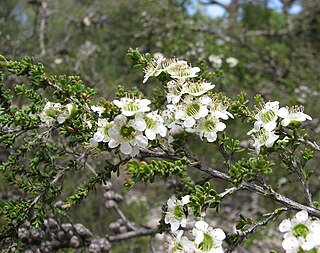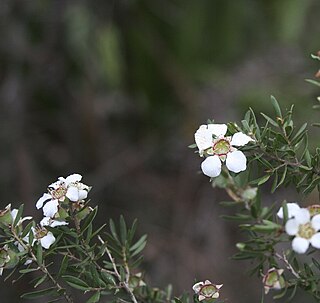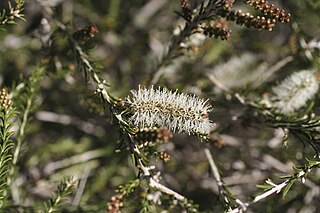
Eucalyptus erythronema, commonly known as the red-flowered mallee, is a species of mallee or tree and is endemic to Western Australia. It has smooth, dark pink to red bark that is shed to reveal whitish bark, and has lance-shaped adult leaves, pendulous flower buds mostly arranged in groups of three, red or yellow flowers and conical fruit.

Leptospermum liversidgei, commonly known as the olive tea-tree, is a species of compact shrub that is endemic to eastern Australia. It has narrow egg-shaped, lemon-scented leaves, white or pink flowers and woody fruit that remain on the plant at maturity.

Darwinia leiostyla is an erect shrub in the family Myrtaceae and is endemic to the south-west of Western Australia. It typically grows to a height of 0.3–1.5 m and has linear leaves up to about 10 mm (0.39 in) long crowded along the branches. Pendent, bell-shaped, flower-like inflorescences appear from May to January. These are clusters of small flowers surrounded by larger pink, red or white, petal-like bracts.

Leptospermum continentale, commonly known as prickly tea-tree, is a species of slender, straggling shrub that is endemic to south-eastern Australia. It has sharp-pointed, narrowly egg-shaped leaves, white flowers arranged singly in leaf axils and woody fruit that remains on the plant when mature.

Leptospermum juniperinum, commonly known as the prickly tea tree, is a species of broom-like shrub that is endemic to eastern Australia. It has narrow, sharply pointed leaves, white flowers usually arranged singly on short side shoots and small fruit that remain on the plant when mature.

Verticordia fastigiata, commonly known as mouse featherflower, is a flowering plant in the myrtle family, Myrtaceae and is endemic to the south-west of Western Australia. It is a prostrate or low shrub with small, club-shaped leaves and mouse-scented flowers which vary in colour from golden-yellow and orange to dark red.

Melaleuca adnata, commonly known as sandhill honey-myrtle, is a plant in the myrtle family, Myrtaceae and is endemic to the south-west of Western Australia. It is a tall shrub with papery bark and spikes of white flowers in spring and early summer.

Melaleuca cucullata is a large shrub in the myrtle family, Myrtaceae and is endemic to the south-west of Western Australia. Its species name alludes to the shape of the leaves which resemble miniature academics' hoods.

Verticordia oxylepis, commonly known as bonsai featherflower, is a flowering plant in the myrtle family, Myrtaceae and is endemic to the south-west of Western Australia. It is a small shrub, often with a layered appearance, small leaves and very small yellow and pink flowers.

Beaufortia puberula, commonly known as hairy-leaved beaufortia, is a plant in the myrtle family, Myrtaceae and is endemic to the southwest of Western Australia. It is a shrub growing to a height of about 2 m (7 ft) with hairy young leaves and heads of hairy, pink or red flowers during most of the year.

Eucalyptus celastroides, commonly known by the Noongar name of mirret, is a species of eucalypt that is endemic to the south-west of Western Australia. It is a mallee, rarely a tree, and has rough bark on about half of the lower half of its tunk, smooth above, narrow lance-shaped adult leaves, flower buds in groups of seven or nine, white flowers and urn-shaped fruit.

Conothamnus aureus is a member of the family Myrtaceae and is endemic to Western Australia. It is a spindly, straggly shrub with rigid, blunt leaves and spherical heads of golden yellow flowers resembling those of wattles.

Leptospermum incanum is a species of compact shrub that is endemic to Western Australia. It has hairy young stems, elongated egg-shaped leaves on a short petiole, relatively large white or pink flowers and fruit that fall from the plant when mature.

Leptospermum nitens is a species of slender shrub that is endemic to Western Australia. It has thin, fibrous bark, narrow egg-shaped to wedge-shaped leaves, white or pink flowers on short side branches and fruit with the sepals attached but that falls from the plant shortly after the seeds reach maturity.
Leptospermum roei is a species of spreading shrub that is endemic to the southwest of Western Australia. It has thin, fibrous bark, long egg-shaped to narrow wedge-shaped leaves, white or pink flowers and small fruit that are shed with the seeds.
Leptospermum subtenue is a species of small shrub in the family Myrtaceae and is endemic to Western Australia. It has thick, elliptical, concave leaves, white or pink flowers and fruit that falls from the plant when mature. It occurs to the south of Kalgoorlie.

Leptospermum multicaule, commonly known as the silver tea-tree, is a species of shrub that is endemic to south eastern Australia. It has linear, narrow elliptical or narrow egg-shaped leaves, white or pink flowers usually borne singly on short side shoots, and fruit the falls from the plant soon after the seeds are released.

Leptospermum parvifolium, commonly known as lemon-scented tea-tree, is a species of shrub that is endemic to eastern Australia. It has thin, rough bark, egg-shaped leaves with the narrower end towards the base, white or pink flowers, and fruit with the remains of the sepals attached but that is shed when the seeds are mature.

Leptospermum myrtifolium, commonly known as the myrtle tea-tree or grey tea-tree, is a species of shrub that is endemic to south eastern Australia. It has broad egg-shaped to elliptical leaves, white flowers usually borne singly on short side shoots, and fruit that remains on the plant until it dies.

Leptospermum sericatum is a species of erect shrub that is endemic to Queensland. It has thin, firm bark, narrow egg-shaped to elliptical leaves, white or pink flowers arranged usually singly on side shoots and fruit that falls from the plant when the seeds are released.


















